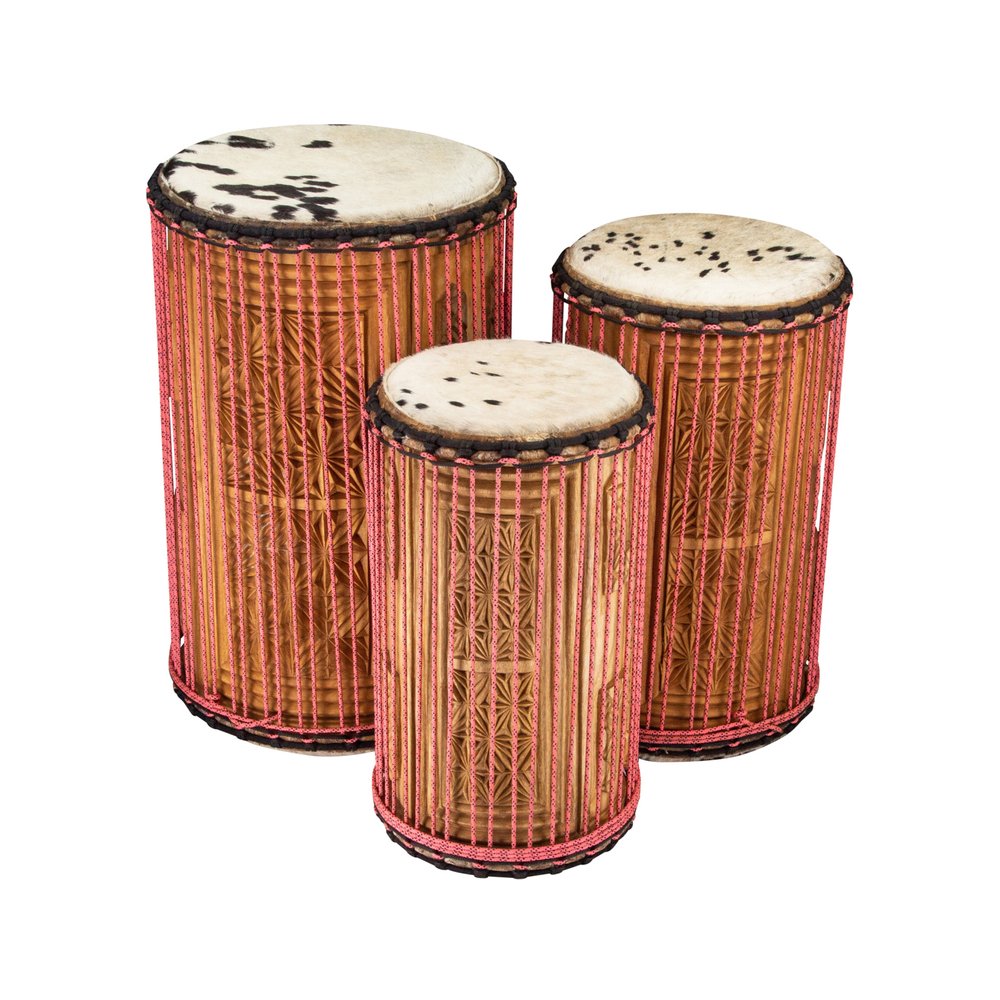Dunun
Percussions
Africa
Between 1001 and 1900 AD
Video
The dunun, also known as dundun or doundoun, is a traditional African drum that plays a vital role in West African music. Characterized by its closed, double-headed cylindrical shape, the dunun is typically constructed from hardwood or metal and is played with a large wooden stick. The drum features two membranes made from animal hides, which are tightly laced to create a resonant sound. The dunun is often part of a larger ensemble that includes other drums like the djembe and serves as a foundational instrument in many musical styles.
Types of Instrument
The dunun family consists of three primary types, each differing in size and pitch:
- Dununba: The largest drum, producing deep, resonant tones that serve as the bass foundation for the ensemble.
- Sangban: A medium-sized drum that offers a balanced sound and plays more complex rhythmic patterns.
- Kenkeni: The smallest drum, known for its higher pitch and often plays simpler rhythms to maintain the overall structure.
These drums are typically played together, creating intricate polyrhythmic patterns that enrich the musical experience.
History
The history of the dunun can be traced back to West Africa, particularly among the Mande people of Mali. It is believed that the drum was developed around the 13th century, coinciding with the rise of powerful kingdoms in the region. The dunun was historically associated with royal ceremonies and events, symbolizing authority and cultural identity. Over time, its use spread across West Africa, influencing various musical traditions in countries such as Senegal, Guinea, and Gambia.
Construction
The construction of a dunun involves careful selection of materials and craftsmanship. Traditionally, the shell is made from hardwoods like cedar or walnut, while modern versions may utilize metal for durability. The drum’s dimensions typically range from 65 cm in length and 40 to 50 cm in diameter for the dununba. The membranes are crafted from goat or cow hide and are secured using interlaced ropes along the sides. This design not only affects sound quality but also allows for tuning adjustments by altering tension on the membranes.
Types
As mentioned earlier, there are three main types of duns:
Dununba: Deep bass tones.
Sangban: Mid-range tones with complex rhythms.
Kenkeni: High-pitched sounds that complement the other drums.
Each type serves a specific role within an ensemble, contributing to the overall texture of the music.
Features
The dunun typically features a cylindrical wooden shell with heads made from stretched animal hides, such as goat or cow skin. The shell is crafted from durable woods like mahogany, offering resonance and durability. It is a double-headed drum, with heads stretched over both ends of the drum and secured by rope tension or metal rings, allowing for fine-tuning. Dunun drums are available in multiple sizes, such as dununba (largest), sangban (medium), and kenkeni (smallest), each contributing distinct pitches and roles within an ensemble. Their combined tonal range adds depth and dynamism to performances. Metal bells, often attached to the drum, create a complementary metallic sound when played in rhythm with the drum.
The dunun’s versatility enables it to serve as both a rhythmic anchor and a melody-shaping instrument in African music. Its design allows players to alternate between stick strikes and bell accents, producing layered and complex rhythms. The instrument’s cultural and functional diversity makes it a vital element of traditional African drumming, ceremonial performances, and contemporary fusion music.
Sound Production
Sound production on the dunun is achieved through striking the membrane with a wooden stick while simultaneously dampening it with the palm or fingertips on the opposite side. This technique allows for varied tonal qualities and rhythmic complexities. Additionally, bells are often attached to some duns to provide an extra layer of rhythm when struck.
Playing Methods
Playing methods for the dunun involve both rhythmic patterns and improvisation. Drummers typically play standing up or seated, using one hand to strike while controlling resonance with their other hand. Each type of dunun contributes uniquely to ensemble performances:
- The dununba provides foundational beats.
- The sangban adds syncopated rhythms.
- The kenkeni maintains tempo with higher-pitched notes.
This interplay creates a rich tapestry of sound that is essential in traditional West African music.
Roles in Music
In West African music, the dunun serves several crucial roles:
Rhythmic Foundation: It provides a solid base upon which other instruments can build their melodies.
Cultural Significance: The drum holds historical importance in ceremonies and celebrations, often linked to community identity.
Dance Accompaniment: Dunun rhythms are integral to traditional dances, guiding movements and enhancing performance dynamics.
Overall, the dunun is not just an instrument; it embodies cultural heritage and communal expression through its sound and significance in various musical contexts.
FAQ
What materials are Dunun drums made of?
Dunun drums are traditionally made from hollowed-out hardwood, such as logwood or mahogany, to provide durability and deep resonance. The drumheads are crafted from animal skins, such as cow or goat hide, stretched tightly over the drum's ends. Metal rings and rope are used to secure the skin and tune the drum. These materials give the Dunun its characteristic rich, booming sound.
Where did Dunun drums originate?
Dunun drums originate from West Africa, specifically in countries like Guinea, Mali, and Burkina Faso. They are a core part of traditional Mandé music and are often played alongside djembe drums. Historically, Dunun drums were used in ceremonies, celebrations, and as a tool for communication. Today, they are widely recognized in world music ensembles.
What are the different types of Dunun drums?
There are three primary types of Dunun drums: the Dundunba, Sangban, and Kenkeni. The Dundunba is the largest and produces a deep, resonant bass sound. The Sangban is medium-sized and offers a balanced tone. The Kenkeni is the smallest and provides high-pitched, rhythmic accents. Together, they create a rich, layered rhythm.
 Links
Links
References
Other Instrument
Categories


















